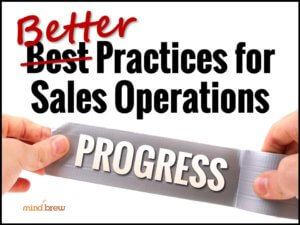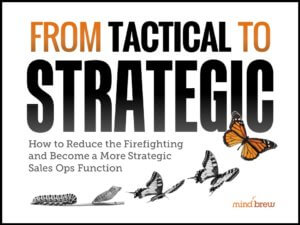From lack of budget and resources to a dearth of time and organizational support, sales ops teams can cite any number of “reasons” for putting off improvement initiatives. Sometimes, these reasons are legit, albeit temporary. More often than not, however, these reasons are really just excuses.
One of the more puzzling excuses often plays out like this:
A sales ops team studies their situation and identifies huge capability gaps in the areas of prospect targeting, account expansion, and sales negotiation.
Instead of relying on detailed, specific, and data-driven targeting criteria, the hunter team just goes after any company with revenues greater than $100M. On the other hand, the farmer team has little or no idea as to the specific wallet-share growth opportunities with their existing customers. And not being trained to know any better, both of these sales teams will fall for every negotiation trick in the book.
But after identifying these big improvement opportunities, the sales ops team then considers what it will take to develop, test, and operationalize the robust solutions that currently define “best practice” in each of these areas.
Whoa! OMG! Best practice is really far away! And getting anywhere close to best practice in just one of the three areas will be a massive undertaking!
Eventually, addressing the big gaps is deemed to be “too much” and the team turns their attention toward more “realistic” and “doable” projects. Of course, these more modest efforts will tend to have very little value or overall impact. But it’s not the sales ops team’s fault that the big opportunities are so far out of reach, right?
There’s so much wrong with this “all or nothing” excuse, it’s hard to know where to begin…
First of all, focusing your limited resources on anything other than the most valuable and impactful improvement opportunities you can find is a huge mistake. I mean, it’s one thing if you don’t actually know where the big opportunities are located. But to know exactly where the big opportunities are, and yet still choose to focus your resources elsewhere?
To my mind, that’s approaching malpractice.
And who says you have to go all the way from Point A to Point Z, without stopping or taking a detour? Who says there’s only one way to design an initiative? Who says that the best path forward is linear? And who says that “best practice” is the only worthwhile objective to pursue?
The facts of the matter are 1) you can scale and scope any initiative to suit the resources you have available, and 2) even though “best” may be out of reach in the near term, “better” is a big step in the right direction and can have a significant impact on results.
So instead of foregoing their biggest improvement opportunities because the ultimate solutions would just be “too much” for their limited resources, the sales ops team in the example could execute some relatively small improvements across all three areas, and then go back and do it again. And again. And again.
Keep in mind that while these tweaks might be very small, they’re focused on the most valuable and impactful areas of opportunity. As such, this ongoing and cyclical pursuit of “better” will generate much bigger results than even the “best” solutions deployed in less powerful areas.













